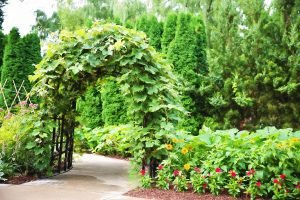Continuing my series of articles for 2019, Materials For A Purpose, I am going to be discussing how best to choose the right materials for your desired purpose and how they best fit into the design of a space. I want to get you thinking about the options you have and how the right selection can give you a cohesive, timeless solution rather than a uninspiring result.
This month I want to investigate products used for level changes.
 Bricks are a classic material to consider when dealing with a level change in a garden. I like to have harmony of materials in my designs so would look to match bricks to the house. Level changes can be small or great depending on the site. Retaining walls that are holding up a body of earth need to be structurally strong. Concrete blocks on a good foundation with attractive facing bricks is a good solid solution. Smaller walls could have a paving stone top as a coping stone which doubles up as a seat. Moving through a level change will often need steps. Brick risers with a paving stone tread is a good solution and easy to tie into patio materials.
Bricks are a classic material to consider when dealing with a level change in a garden. I like to have harmony of materials in my designs so would look to match bricks to the house. Level changes can be small or great depending on the site. Retaining walls that are holding up a body of earth need to be structurally strong. Concrete blocks on a good foundation with attractive facing bricks is a good solid solution. Smaller walls could have a paving stone top as a coping stone which doubles up as a seat. Moving through a level change will often need steps. Brick risers with a paving stone tread is a good solution and easy to tie into patio materials.
Sleepers have become very popular as a retaining product for level change in garden design. This is primarily due to the cost of a traditional wall built from small brick units compared to the longer units of a sleeper. Basically, you cover more ground with a sleeper. However, timber does not have the longevity of brick despite being cheaper. Best practice would be to use tanalised sleepers and protect the wood in contact with the earth with a dpc barrier or protective paint. This will help extend the life of the wood in contact with the earth. New soft wood sleepers are great to build with due to their uniformity of size. Oak sleepers are more expensive and although very attractive require more labour time for building with as they are harder to cut and less uniform in size. Sleepers make good steps through a level change and look especially good when used with other products such as gravel or paving to form the tread. In the spirit of low maintenance gardening many clients now love to have raised beds in the garden and sleepers are great for this. Not only do soft wood sleepers cut easily they fit well with timber lock bolts that you fire into the wood with an impact driver drill.
Gabions are a less well-known product that provide great strength and stability when used to retain earth in a garden design. The principle is wire cages that are levelled, joined together and filled with stones. It is quite a municipal solution and most relevant in contemporary spaces. As with all things the devil is in the detail. It is not just a case of tipping stones into wire cages. For the best results the outside facing stones need to be placed and the top stones arranged to give a good finished top surface. The choice of stone will dictate the cost of the filling material. I have heard of contractors dressing the outside and top with the decorative stone and filling the internal section with rubble as it is not visible. This would work best if the filling material and the decorative stone are similar sizes otherwise they may begin to move through each other.
Grass slopes are underrated as a low impact solution to level change. Grading the earth with a digger over a distance can reduce a slope gently and easily without the need for a hard-landscaping solution. Grass seed and topsoil is certainly the cheaper option, but every garden is different and when space is restricted this may not be the appropriate option. Often in small gardens earth needs to be removed to make way for development of a space. This can lead to boundary level changes where you could consider using concrete gravel boards to prevent the neighbour’s garden falling into yours. Planting can also be used to disguise a difficult level change.














